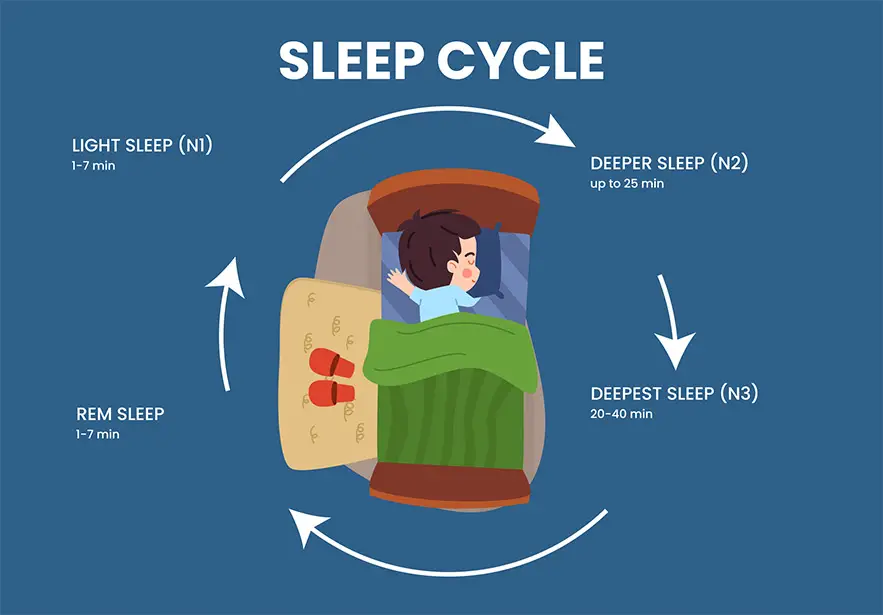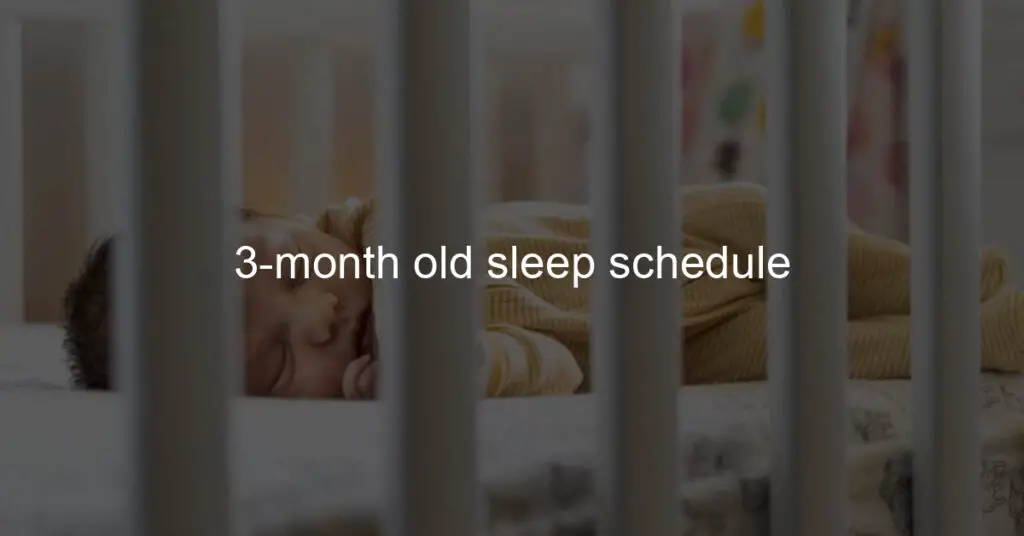Introduction to the 3-Month-Old Sleep Schedule
As your baby grows, their sleep patterns will change. By the time they reach three months old, you may notice a shift in their sleep schedule. This article will provide an overview of what to expect and why sleep is so crucial at this stage of development.
Understanding the Importance of Sleep for a 3-Month-Old
Sleep is vital for a 3-month-old baby. It’s during this time that their bodies grow and develop. According to the National Sleep Foundation, infants need about 14-17 hours of sleep a day. This includes nighttime sleep and naps. Sleep also plays a significant role in brain development. It helps with memory consolidation and learning new skills. Therefore, ensuring your baby gets enough sleep is crucial for their overall health and development.
Overview of a Typical 3-Month-Old Sleep Schedule
A 3-month-old baby typically sleeps about 14-16 hours a day, including naps. At this age, babies usually have 3-4 naps a day, each lasting about 1-2 hours. Nighttime sleep gradually increases, with most babies sleeping 6-8 hours at a stretch by the end of the third month. However, every baby is unique, and their sleep patterns may vary. It’s essential to watch for signs of sleepiness and establish a consistent sleep routine to help your baby get the rest they need.
Understanding your baby’s sleep schedule can help you provide the best care and support for their growth and development. In the following sections, we’ll delve deeper into the 3-month-old sleep schedule, including wake windows, sleep regression, and transitioning from a newborn sleep schedule to an infant sleep schedule.
Understanding 3 Month Old Wake Windows
When it comes to understanding your 3-month-old’s sleep schedule, the concept of ‘wake windows’ is crucial. But what exactly are wake windows, and how long should your little one be awake? Let’s delve into these questions.
What are wake windows?
A wake window is the period of time that your baby is awake between naps. During this time, your baby feeds, plays, and explores their environment. It’s a crucial part of their development and helps regulate their sleep patterns. As your baby grows, their wake window will gradually extend. However, it’s important not to overstretch this period as it can lead to overtiredness, making it harder for your baby to fall asleep.
How long should a 3 month old be awake?
At 3 months of age, a baby’s wake window typically ranges from 1 to 2 hours. This means after waking from a nap, your baby should ideally be back to sleep within this timeframe. Remember, every baby is unique and may not fit perfectly within these guidelines. It’s essential to watch for signs of sleepiness like yawning, rubbing eyes, or becoming fussy, indicating it’s time for another nap.
Understanding your baby’s wake windows and responding to their sleep cues can make a significant difference in their overall sleep quality and mood. It’s all about finding the right balance and adjusting as your baby grows and changes.
Creating a 3 Month Old Schedule

Creating a schedule for a 3-month-old baby can be a challenging task for many parents. However, with the right information and understanding, it can be made easier. This section will provide a sample schedule that you can use as a guide.
Sample 3-Month-Old Sleep and Feeding Schedule
Every baby is unique and may not adhere strictly to this schedule. However, this sample schedule can serve as a starting point. You can adjust it based on your baby’s needs and your own observations.
Morning wake up and feeding:
Babies usually wake up between 6-7 AM. It’s important to feed them as soon as they wake up. This is usually the time when they are most alert and ready for their first meal of the day.
Mid-morning nap and feeding:
Around 9-10 AM, your baby might be ready for a nap. After they wake up, it’s time for another feeding. This mid-morning nap helps them recharge and prepare for the rest of the day.
Afternoon nap and feeding:
After some playtime and interaction, your baby might be ready for another nap around 1-2 PM. Once they wake up, feed them again. This nap is crucial as it helps them regain their energy for the remaining part of the day.
Evening nap and feeding:
Around 4-5 PM, your baby might need a short nap. After they wake up, it’s time for another feeding. This nap helps them relax and prepare for their nighttime sleep.
Nighttime sleep:
Most 3-month-old babies are ready for bed between 6-8 PM. After their last feeding of the day, they should be ready for a longer sleep period. This is the time when they consolidate their learning and growth from the day.
Remember, this is just a sample schedule. Your baby might not follow this exactly, and that’s perfectly okay. The key is to observe your baby’s cues and adjust the schedule accordingly. This will ensure that your baby gets the right amount of sleep and nutrition they need for their growth and development.
Dealing with 3 Month Old Sleep Regression
Sleep regression is a phase that most babies go through. It can be a challenging time for both parents and babies. In this section, we will explore what sleep regression is, the signs of sleep regression in a 3-month-old, and how to handle it.
What is sleep regression?
Sleep regression is a period when a baby who has been sleeping well suddenly starts waking up at night, and has difficulty falling asleep again. This is a normal part of a baby’s development and is typically linked to growth spurts and brain development. It usually lasts for 2-6 weeks. Wikipedia provides more detailed information about sleep regression.
Signs of sleep regression in a 3-month-old
There are several signs that your 3-month-old might be going through a sleep regression. These include:
Increased fussiness
Frequent night wakings
Difficulty falling asleep at naptime and bedtime
Changes in appetite
Remember, every baby is unique and may exhibit different signs.
How to handle sleep regression
Handling sleep regression can be a challenge, but there are several strategies that can help:
Consistent bedtime routine: A consistent bedtime routine can signal to your baby that it’s time to sleep. This routine could include a bath, a book, and a lullaby.
Comforting environment: Ensure your baby’s sleep environment is comfortable, quiet, and dark. A white noise machine can also help soothe your baby to sleep.
Patience: Remember, this phase is temporary. It’s important to remain patient and understanding as your baby navigates this developmental phase.
Dealing with a 3-month-old’s sleep regression can be tough, but remember, it’s a normal part of their development and it won’t last forever. Stay patient, maintain a consistent routine, and soon enough, your little one will be back to their regular sleep schedule.
3 Month Old Sleeping 8 Hours Straight: Is It Possible?

Many parents wonder if their 3-month-old baby can sleep for 8 hours straight. While every baby is unique, it’s important to understand the typical sleep needs of a 3-month-old and how to encourage longer sleep periods.
Understanding the sleep needs of a 3-month-old
At 3 months old, babies typically sleep about 14 to 16 hours a day, including naps. However, most babies this age can’t stay asleep for more than 4 to 6 hours at a time. This is because their small stomachs don’t hold enough breast milk or formula to keep them satisfied for 8 hours. Also, their sleep cycles are shorter than those of adults, and they spend more time in rapid eye movement (REM) sleep, which is easier to wake from. Learn more about infant sleep on Wikipedia.
How to encourage longer sleep periods
While it’s unlikely that a 3-month-old will sleep for 8 hours straight, there are ways to encourage longer sleep periods. Here are a few tips:
Establish a bedtime routine: This can include a bath, a book, and a lullaby. The routine signals to your baby that it’s time to wind down and go to sleep.
Feed your baby right before bed: A full belly can help your baby sleep longer.
Put your baby to bed when they’re sleepy but awake: This can help your baby learn to self-soothe and fall asleep on their own.
Keep the room dark and quiet: This can help your baby understand that night time is for sleeping.
Remember, every baby is different. What works for one might not work for another. It’s important to be patient and flexible as you figure out what works best for your baby.
In conclusion, while it’s possible for a 3-month-old to sleep for 8 hours straight, it’s not very common. It’s more important to focus on creating a healthy sleep environment and routine for your baby. With time, your baby will start sleeping for longer periods.
Transitioning from Newborn Sleep Schedule to Infant Sleep Schedule
As your little one grows, their sleep schedule will naturally evolve. This transition from a newborn sleep schedule to an infant sleep schedule can be a significant change for both baby and parents. It’s essential to understand the key differences between these two stages and learn some tips for a smooth transition.
Key differences between newborn and infant sleep schedules
Newborns typically sleep in short bursts throughout the day and night, totaling up to 16-18 hours. They have yet to develop a circadian rhythm, which is the body’s internal clock that tells us when to sleep and wake up. This is why newborns have irregular sleep patterns.
On the other hand, infants, particularly around the 3-month mark, start to sleep for longer stretches at night and have more wakeful periods during the day. They begin to develop a more regular sleep pattern as their circadian rhythm starts to take shape. This is influenced by environmental cues like light and darkness.
Infants also require fewer naps during the day compared to newborns. While a newborn might nap every 2-3 hours, an infant will start to consolidate their sleep into fewer, longer naps.
Tips for a smooth transition
1. Establish a consistent bedtime routine: This can signal to your baby that it’s time to sleep. The routine might include a bath, a book, and a lullaby before bed.
2. Pay attention to sleep cues: Your baby will show signs when they’re tired, such as rubbing their eyes, yawning, and becoming fussy. Putting them to bed when they first show these signs can make it easier for them to fall asleep.
3. Gradually adjust nap times: As your baby grows, they’ll need fewer naps. You can gradually push back the first nap of the day to help this transition.
4. Ensure a sleep-friendly environment: Make sure your baby’s room is quiet, dark, and at a comfortable temperature to promote better sleep.
Remember, every baby is unique and will transition at their own pace. Be patient and flexible, and consult your pediatrician if you have any concerns about your baby’s sleep.
Common Challenges in Baby Sleep Schedule
Establishing a consistent sleep schedule for a baby can be a challenging task for many parents. There are several common issues that can arise, such as difficulty in falling asleep, frequent night awakenings, and short naps during the day. Understanding these challenges can help parents find effective solutions and ensure a good night’s sleep for their little ones.
Case Study: Overcoming Sleep Schedule Challenges
Let’s look at a case study of a parent who successfully overcame sleep schedule challenges with their 3-month-old baby.
Identifying the problem
The baby was having trouble falling asleep at night and would frequently wake up. The parent noticed that the baby seemed overtired and fussy, especially in the late afternoon and evening.
Implementing a solution
The parent decided to implement a consistent bedtime routine to help signal to the baby that it was time to sleep. This routine included a warm bath, a bedtime story, and a lullaby. They also made sure to keep the environment quiet and dimly lit during this time. Additionally, they started to pay closer attention to the baby’s wake windows during the day to prevent the baby from becoming overtired.
Observing the results
After a few weeks of implementing this routine, the parent noticed a significant improvement in the baby’s sleep schedule. The baby was falling asleep more easily at night and waking up less frequently. The baby also seemed less fussy and more content during the day.
As this case study shows, understanding and addressing the challenges in a baby’s sleep schedule can lead to positive results. It’s important to remember that every baby is unique and what works for one may not work for another. Therefore, it may take some trial and error to find the best sleep schedule for your baby.
Key Takeaways on Mastering the 3-Month-Old Sleep Schedule
As we conclude our comprehensive guide on the 3-month-old sleep schedule, let’s recap the most essential points to remember. These key takeaways will help you navigate this critical stage of your baby’s development with confidence and ease.
Importance of Consistency in Sleep Schedules
Consistency is the cornerstone of a successful sleep schedule. Establishing and maintaining a regular sleep routine for your baby can help regulate their internal body clock, leading to better sleep quality and duration. A consistent sleep schedule also provides predictability, which can be comforting for your baby and make bedtime less stressful for both of you.
Understanding and Responding to Your Baby’s Sleep Cues
Every baby communicates their need for sleep differently. Some may rub their eyes, yawn, or become fussy. Recognizing these sleep cues and responding promptly can prevent your baby from becoming overtired, which can make it harder for them to fall asleep. Remember, an overtired baby is often a sleep-resistant baby.
Patience and Flexibility in Dealing with Sleep Regression
Sleep regression is a common challenge for 3-month-old babies. It’s a period when your baby’s sleep pattern can suddenly change, often resulting in more frequent night wakings and shorter naps. While it can be frustrating, remember that sleep regression is temporary and a sign of your baby’s growth and development. Stay patient, be flexible, and continue to support your baby’s sleep needs during this time.
In conclusion, mastering the 3-month-old sleep schedule requires understanding your baby’s unique sleep needs, maintaining consistency, and being patient during periods of sleep regression. With these key takeaways, you’re well-equipped to support your baby’s sleep and foster healthy sleep habits that can last a lifetime.















